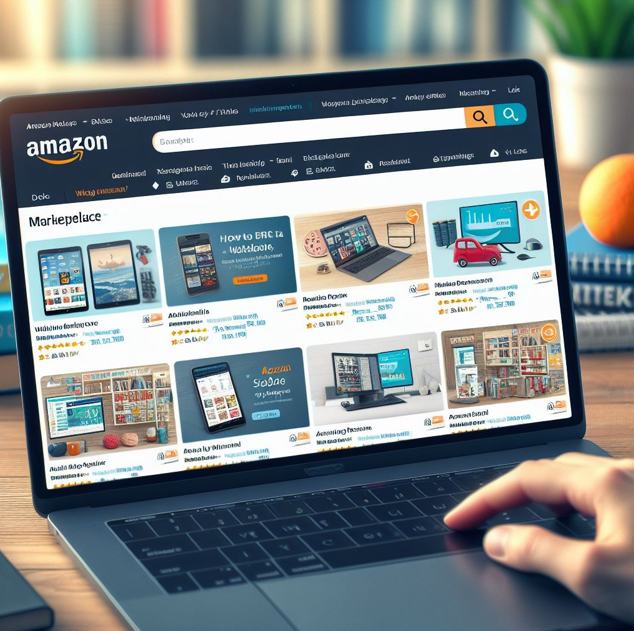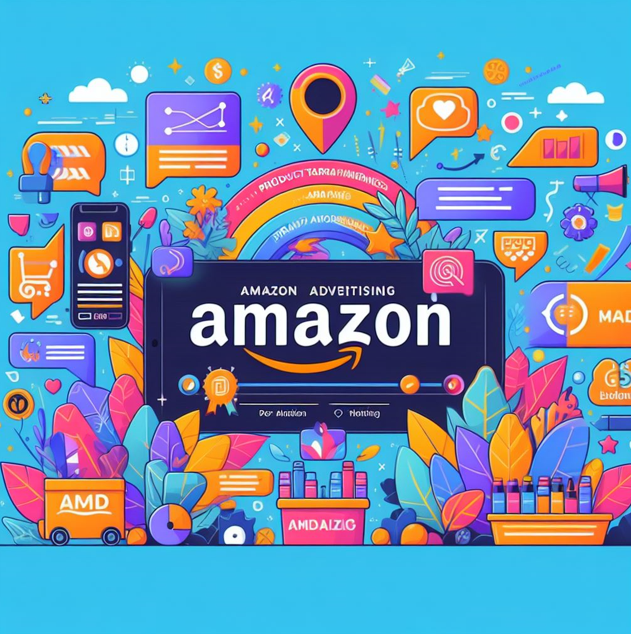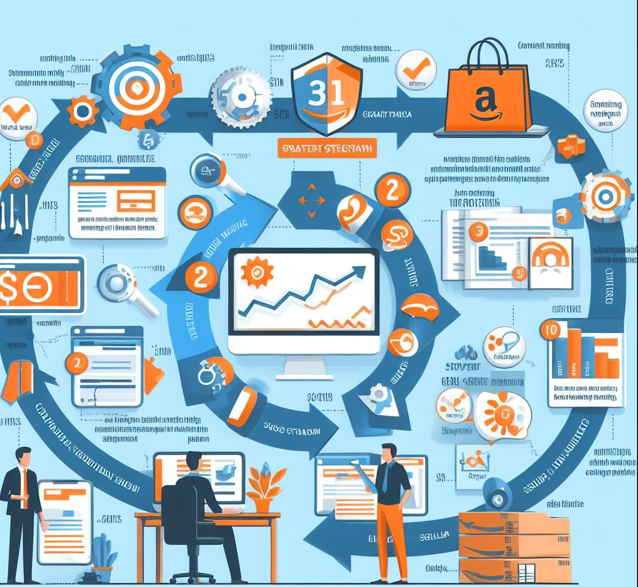I. Introduction
A. Why Amazon Digital Marketing?
Did you know that there are over 2 million active sellers on Amazon, and only a fraction of them are effectively using digital marketing strategies? This fierce competition makes it crucial for sellers to stand out and reach their target audience effectively.
B. What is Amazon Digital Marketing?
- Amazon digital marketing encompasses all online marketing efforts aimed at promoting your products and brand on the Amazon marketplace.
- It includes strategies like:
- Search engine optimization (SEO) to improve product visibility in search results.
- Pay-per-click (PPC) advertising to reach targeted audiences through sponsored ads.
- Content marketing to create valuable content that educates and engages potential customers.
- Social media marketing to build brand awareness and connect with customers on popular platforms.
C. Why is Amazon Digital Marketing Important?
- Increased visibility: Reach more potential customers and improve your chances of getting discovered on Amazon.
- Enhanced brand awareness: Build brand recognition and establish trust with your target audience.
- Boosted sales and conversions: Drive traffic to your product listings and convert viewers into buyers.
- Improved customer engagement: Interact with your audience, answer their questions, and build customer loyalty.
Call to Action:
Ready to unlock the potential of Amazon digital marketing for your business? Let’s dive deeper and explore the essential elements you need to know!

II. Understanding the Amazon Marketplace
A. Amazon Seller Types
There are three main types of sellers on Amazon:
| Seller Type | Description |
| Individual Seller | Sells individual items occasionally, ideal for beginners with limited inventory. |
| Professional Seller | Sells a higher volume of products, has access to additional selling features, and incurs monthly subscription fees. |
| Vendor | Sells products directly to Amazon at wholesale prices, and Amazon manages fulfillment and customer service. |
C. Amazon Search Algorithm
The Amazon search algorithm, known as A9, determines the order in which products appear in search results. While the exact formula is not publicly available, some known factors influencing product ranking include
- Keyword relevance: How well your product listing matches the keywords buyers are searching for.
- Product title, description, and features: Providing detailed and accurate information about your product.
- Product reviews and seller feedback: Positive reviews and high seller ratings can significantly boost your ranking.
- Price and fulfillment options: Competitive pricing and offering Amazon Prime fulfillment can improve visibility.
D. Key Performance Indicators (KPIs) for Amazon Sellers
Here are some essential KPIs to track and analyze the effectiveness of your Amazon digital marketing efforts:
- Impressions: The number of times your product listing is displayed in search results.
- Clicks: The number of times buyers click on your product listing.
- Conversion Rate: The percentage of clicks that result in a sale.
- Return on Ad Spend (ROAS): A metric that measures the profitability of your advertising campaigns.
These KPIs are crucial for understanding your audience, optimizing your listings, and measuring the success of your marketing strategies.

III. Amazon Advertising Solutions
A. Overview of Amazon Advertising
Amazon Advertising offers a comprehensive suite of tools and solutions to help sellers reach their target audience and increase product visibility. These solutions cater to various campaign objectives, from brand awareness and consideration to driving sales and conversions.
B. Sponsored Products Ads
What are they? Sponsored Products ads are the most common advertising format on Amazon. They allow you to display your product listings within search results pages and product detail pages, reaching potential customers actively searching for relevant products.
How do they work?
- Targeting: You can target your ads based on relevant keywords, product categories, competitor products, and customer demographics.
- Bidding: You set a maximum bid amount you are willing to pay each time someone clicks on your ad.
- Auction: Your ad competes with other sellers’ ads based on various factors, including your bid, product relevance, and historical performance.
- Placement: Winning bids determine where your ad appears on the search results page or product detail page.
Campaign types:
- Automatic Campaigns: Ideal for beginners, Amazon automatically manages targeting and bidding strategies.
- Manual Campaigns: Offer more control over targeting, bidding, and placements.
- Sponsored Display Campaigns: Reach customers beyond Amazon search results pages through targeted placements on other websites and apps.
Optimization Tips:
- Optimize your product listings: Ensure clear, informative titles, descriptions, and high-quality images.
- Conduct keyword research: Identify relevant keywords with high search volume and low competition.
- Set competitive bids: Balance your budget with the potential return on ad spend (ROAS).
- Monitor and adjust your campaigns: Regularly track performance metrics and adjust strategies to improve results.
C. Sponsored Brands Ads
What are they? Sponsored Brands ads go beyond individual product listings and allow you to promote your brand directly within Amazon search results. They come in various formats:
- Headline Search Ads: Feature your brand logo, a custom headline, and three product listings.
- Product Display Ads: Showcase your brand logo and a carousel of your products.
- Sponsored Brand Video Ads: Increase brand awareness through engaging video ads displayed on product detail pages and throughout Amazon.
Benefits:
- Increase brand awareness and recognition.
- Drive traffic to your brand store or product listings.
- Differentiate yourself from competitors.
D. Sponsored Display Ads
What are they? Sponsored Display ads allow you to reach potential customers beyond Amazon search results pages. These ads are displayed on other websites and apps frequented by users who have shown interest in products similar to yours.
Targeting options:
- Automatic targeting: Leverages Amazon’s algorithms to reach relevant audiences based on browsing behavior and purchase history.
- Product targeting: Target users who have viewed or purchased similar products.
- Lifestyle targeting: Reach audiences based on interests, demographics, and purchase behavior.
E. Amazon DSP (Demand-Side Platform)
What is it? Amazon DSP is a programmatic advertising platform for experienced advertisers. It allows for more advanced campaign management, targeting options, and audience segmentation capabilities compared to traditional Amazon advertising solutions.
Benefits:
- Reach a wider audience across various websites and apps.
- Utilize advanced targeting strategies for precise audience reach.
- Gain deeper insights into campaign performance and audience behavior.
F. Other Advertising Options
- Amazon Vine: A program that allows you to send free products to reviewers in exchange for unbiased feedback.
- Amazon Live: Host live product demonstrations and interact with potential customers in real-time.
- Influencer marketing: Partner with relevant influencers to promote your products to their audience.
Remember, choosing the right advertising solution depends on your specific goals, budget, and target audience.

IV. Content Marketing for Amazon Sellers
A. The Power of Content Marketing on Amazon
In today’s competitive landscape, simply listing your products on Amazon isn’t enough. Content marketing plays a crucial role in attracting customers, building brand loyalty, and ultimately driving sales. By creating valuable and informative content, you can:
- Educate and engage your target audience: Provide helpful information about your products, their uses, and benefits.
- Improve brand awareness and establish trust: Showcase your expertise and build a strong brand reputation.
- Influence the buyer journey: Guide potential customers through different stages of the buying process, from awareness to consideration and purchase.
- Boost organic search ranking: Optimize your content with relevant keywords to improve product visibility in search results.
B. Types of Content for Amazon Sellers
- Product listings and descriptions: Optimize your listings with clear, concise titles, detailed descriptions, and high-quality images. Utilize relevant keywords throughout to improve search ranking.
- Blog posts and articles: Create valuable content related to your products, target audience, and industry. Share informative articles, buying guides, product comparisons, and how-to guides.
- Infographics, videos, and other engaging content formats: Utilize visuals like infographics, product demonstration videos, and customer testimonials to capture attention and effectively communicate your message.
C. Building a Brand Story
Developing a compelling brand story is crucial for connecting with your audience on an emotional level. This story should reflect your brand values, mission, and what makes you unique.
- Highlight your brand’s unique selling proposition (USP).
- Showcase your commitment to quality and customer satisfaction.
- Share the story behind your brand and its founders.
- Connect with your audience on a personal level and evoke positive emotions.
D. Utilizing Amazon A+ Content
Amazon A+ Content allows you to create rich product descriptions with enhanced features like:
- High-quality images and videos.
- Comparison charts and tables.
- Bullet points and numbered lists for improved readability.
By leveraging A+ Content, you can showcase your products’ features and benefits in a visually appealing and informative way, ultimately leading to higher conversion rates.
E. Off-Amazon Content Marketing Strategies
Don’t limit your content marketing efforts solely to Amazon. Promote your brand and products on other platforms to reach a broader audience and drive traffic back to your Amazon listings.
- Social media marketing: Share engaging content on relevant social media platforms like Facebook, Instagram, and Pinterest.
- Email marketing: Build an email list and send targeted campaigns with product updates, promotions, and valuable content.
- Collaborations and partnerships: Partner with other businesses, influencers, or bloggers in your niche to reach their audience and gain exposure.
By implementing a comprehensive content marketing strategy, you can effectively attract potential customers, build brand loyalty, and ultimately achieve long-term success on Amazon.

V. Social Media Marketing for Amazon Sellers
A. Choosing the Right Social Media Platforms
Social media marketing can be a powerful tool for Amazon sellers to connect with potential customers, build brand awareness, and drive sales. However, it’s crucial to choose the right platforms where your target audience spends their time. Here are some factors to consider:
- Target audience demographics: Understand the age, interests, and online behavior of your ideal customers.
- Platform strengths: Each platform caters to different types of content and user engagement.
- Your brand voice and message: Ensure your social media presence aligns with your overall brand image and messaging.
Here are some popular social media platforms for Amazon sellers:
- Facebook: Offers a massive user base and diverse targeting options. Ideal for sharing product updates, promotions, and engaging content like blog posts and videos.
- Instagram: Primarily visual platform, perfect for showcasing high-quality product images and behind-the-scenes glimpses. Utilize relevant hashtags to reach a wider audience.
- Pinterest: Image-driven platform, ideal for sharing visually appealing product images and infographics. Create boards related to your products and target audience interests.
- Twitter: Real-time platform, suitable for promoting deals, running contests, and interacting with customers in real-time.
B. Creating Engaging Social Media Content
Once you’ve chosen your platforms, focus on creating engaging content that resonates with your audience. Here are some tips:
- Share a variety of content formats: Images, videos, short-form videos (e.g., Reels, TikTok), live streams, and informative text posts.
- Go beyond just selling: Offer valuable tips, industry insights, and behind-the-scenes glimpses to build brand connection.
- Run contests and giveaways: Generate excitement and encourage audience participation.
- Respond to comments and messages: Foster interaction and provide excellent customer service.
- Utilize relevant hashtags: Increase discoverability and reach a wider audience.
C. Running Social Media Ads
Social media platforms offer paid advertising options to reach a targeted audience beyond your organic following. Consider running social media ads to:
- Promote specific products or special offers.
- Increase brand awareness and reach new audiences.
- Drive traffic to your Amazon listings or brand website.
By effectively utilizing social media marketing, you can connect with potential customers, build brand loyalty, and ultimately drive sales for your Amazon business.

VI. Additional Amazon Digital Marketing Strategies
Beyond the core strategies covered so far, several other tactics can enhance your Amazon digital marketing efforts:
A. Amazon Reviews and Seller Feedback
- Positive reviews and high seller ratings significantly impact buying decisions on Amazon. Encourage satisfied customers to leave reviews by providing excellent customer service and sending polite follow-up requests.
- Respond to all reviews promptly and professionally, addressing both positive and negative feedback. This demonstrates your commitment to customer satisfaction and helps build trust.
B. Amazon Deals and Promotions
- Run limited-time promotions like flash sales, Lightning Deals, and coupons to attract new customers and boost sales.
- Participate in Amazon sales events like Prime Day and Black Friday to gain increased visibility and reach a wider audience.
- Utilize Amazon Seller Central tools like Amazon Promotions and Deals Dashboard to manage and track your promotional activities effectively.
C. Amazon Email Marketing
- Leverage Amazon Seller Central tools like Seller Central messaging and Sponsored Brands emails to reach your customer base directly.
- Segment your audience based on purchase history, interests, and demographics to personalize your email communication.
- Craft engaging email campaigns with valuable content, product recommendations, and special offers to nurture customer relationships and drive repeat business.
D. Influencer Marketing
- Collaborate with relevant influencers in your niche who have an established audience interested in your products.
- Partner on sponsored content, product reviews, or social media promotions to leverage the influencer’s reach and credibility.
- Ensure the influencer aligns with your brand values and target audience for an authentic and effective partnership.
E. Amazon DSP (Demand-Side Platform) – Advanced Strategies
While briefly mentioned earlier, Amazon DSP offers advanced features and functionalities for experienced advertisers:
- Utilize programmatic buying: Automate ad purchasing across various websites and apps based on predefined criteria, like demographics and browsing behavior.
- Leverage audience segmentation: Create highly targeted segments based on various factors to reach specific customer groups effectively.
- Gain deeper insights: Analyze campaign performance data in greater detail to optimize strategies and maximize return on ad spend (ROAS).
Remember, a successful Amazon digital marketing strategy requires a combination of different tactics, tailored to your specific goals, target audience, and budget. By consistently monitoring and analyzing your efforts, you can refine your approach and achieve your desired results on the Amazon marketplace.

Your article on affiliate marketing was highly informative.